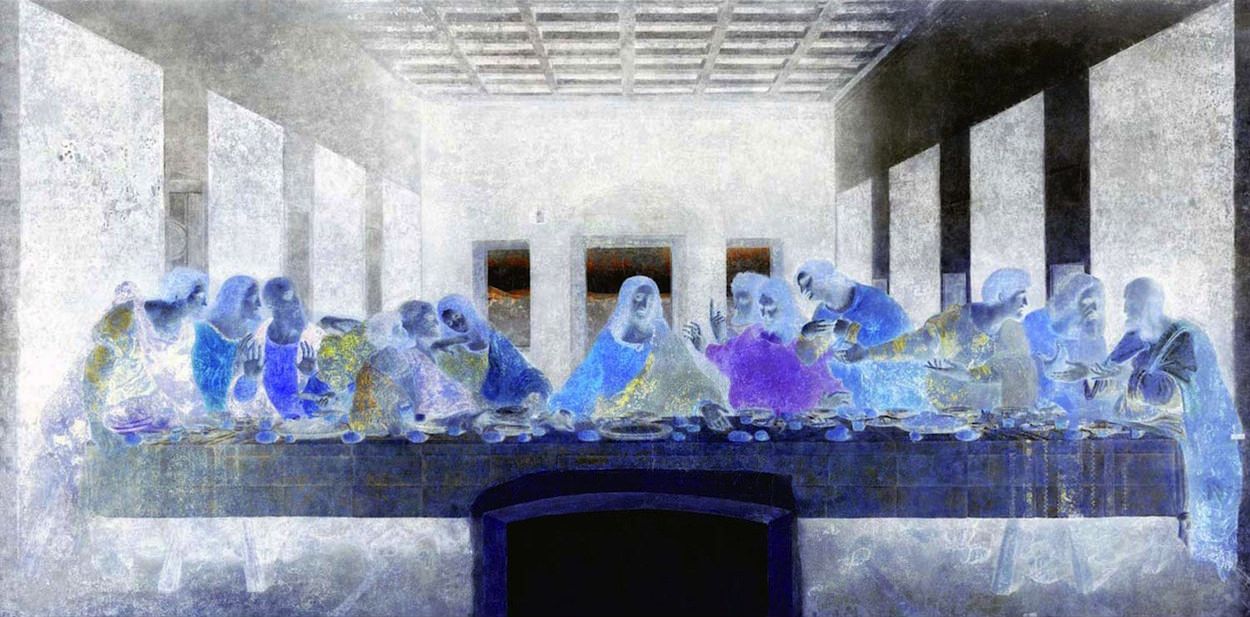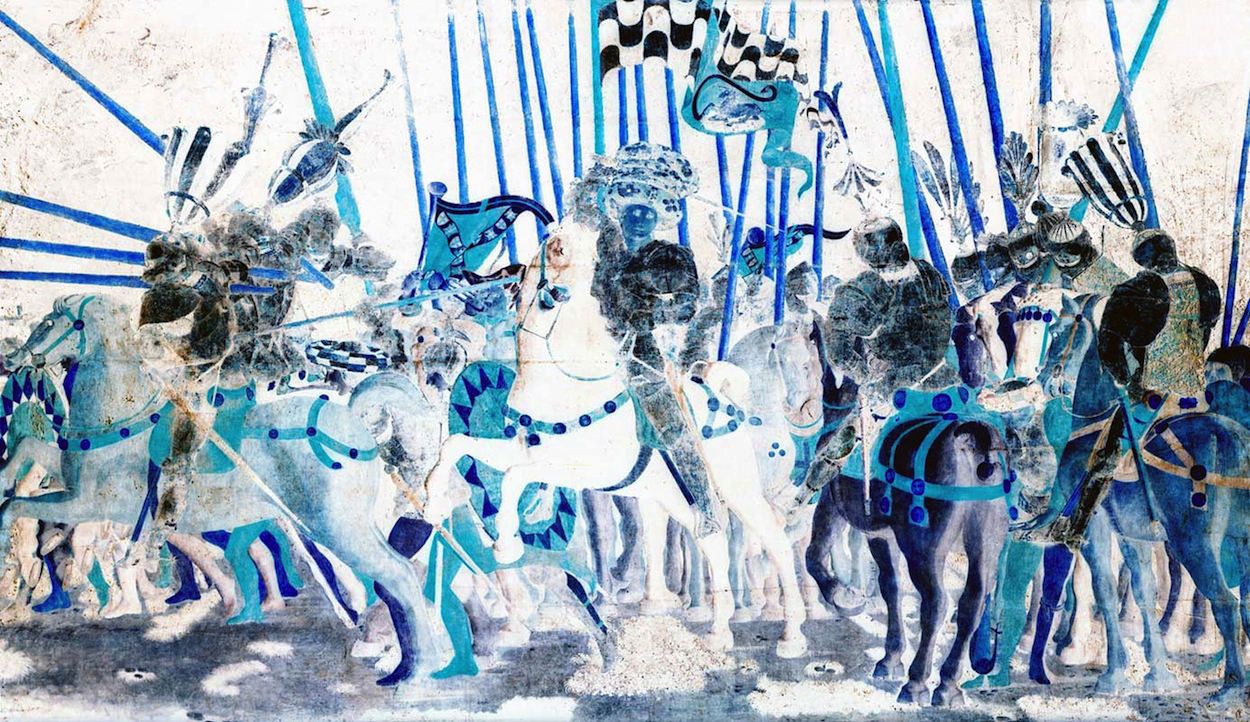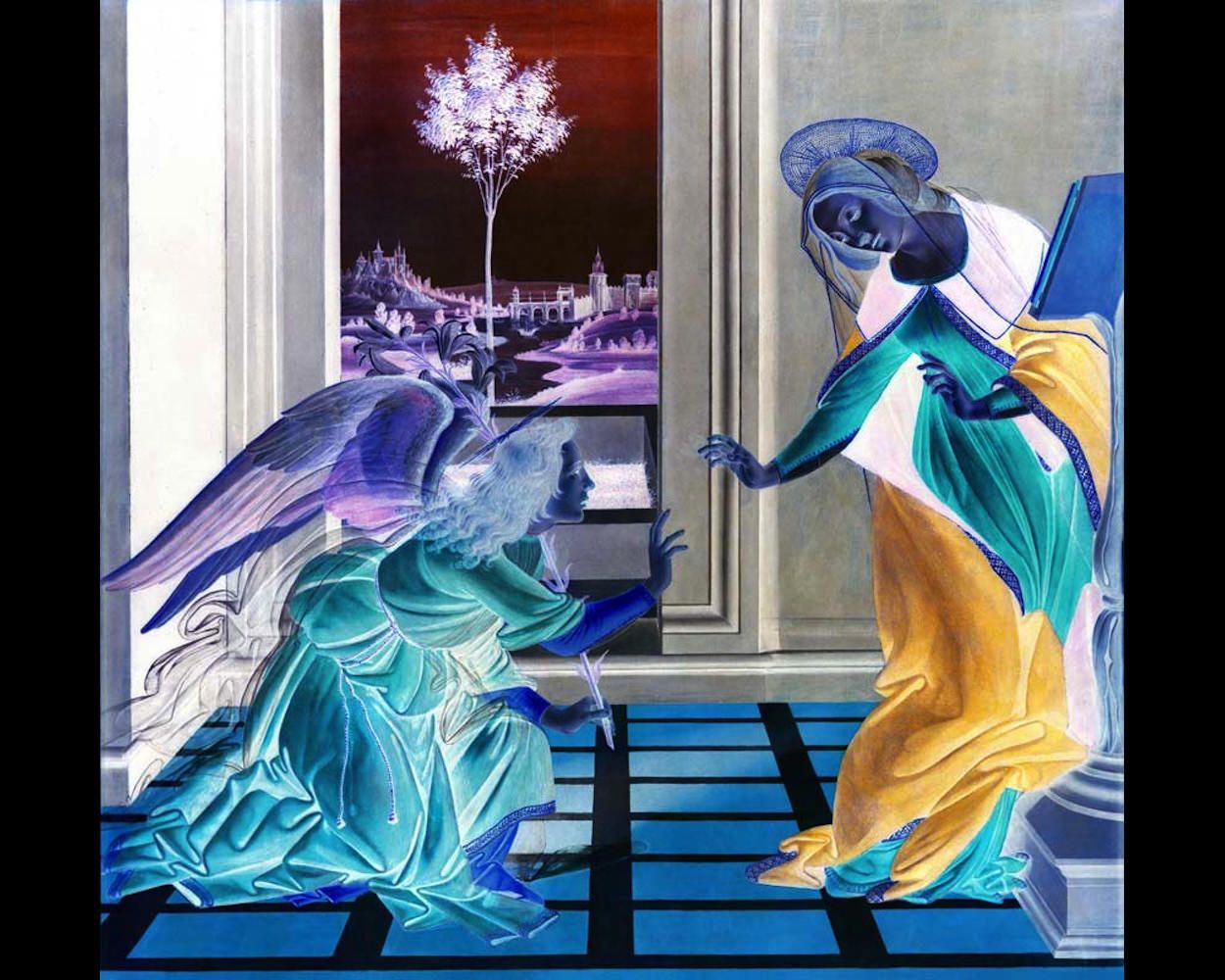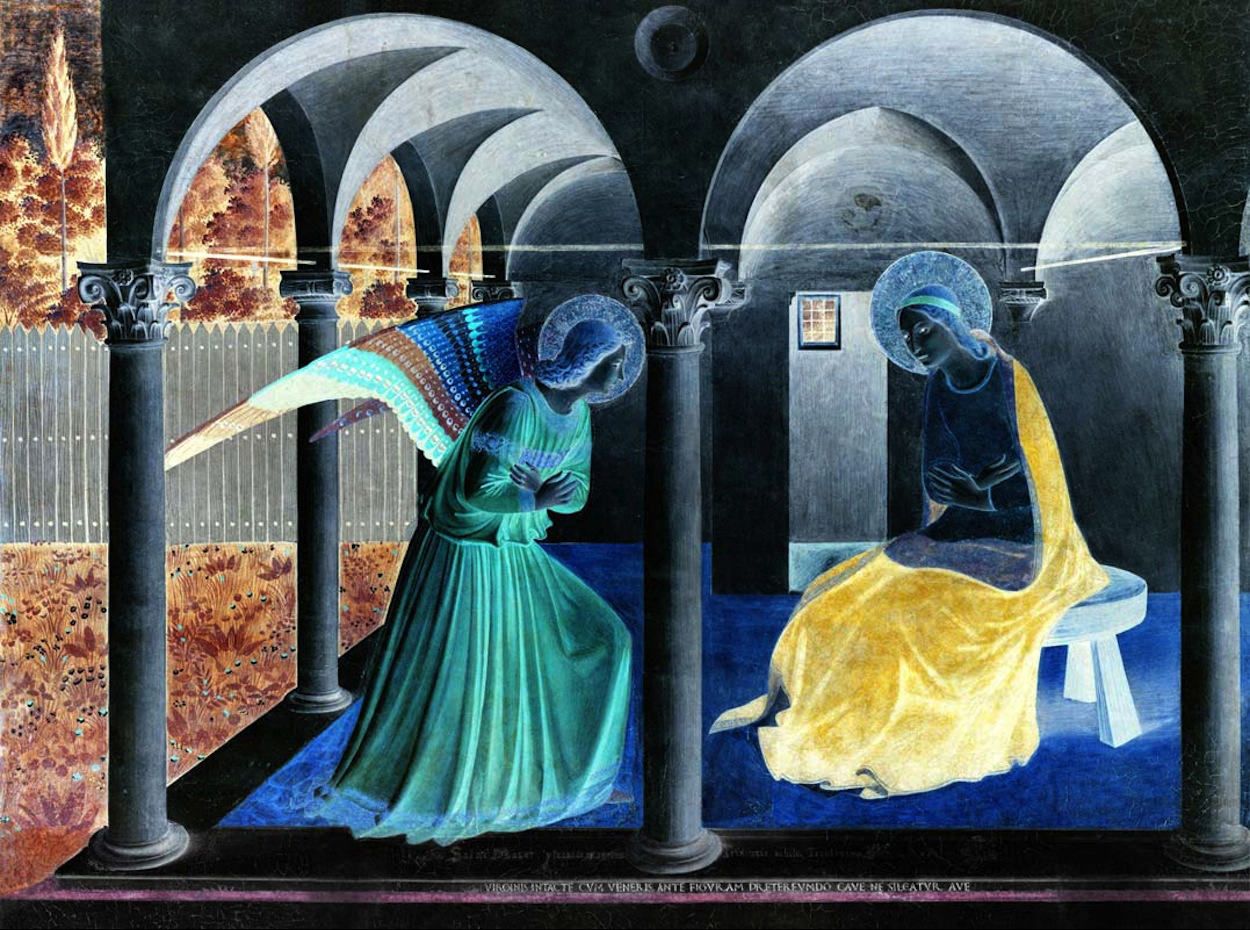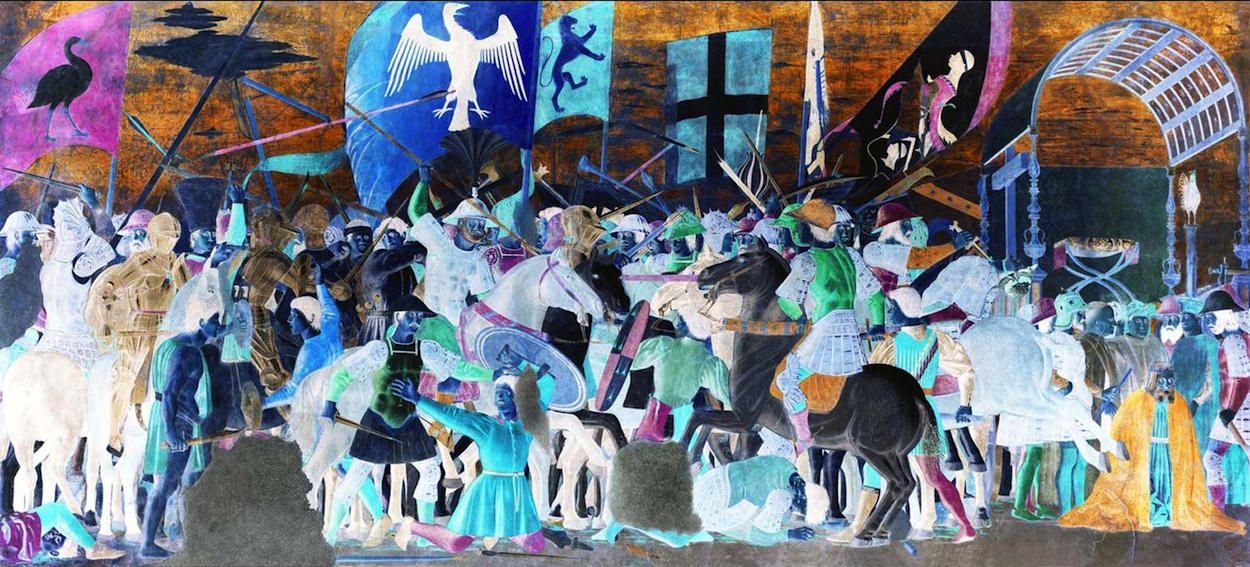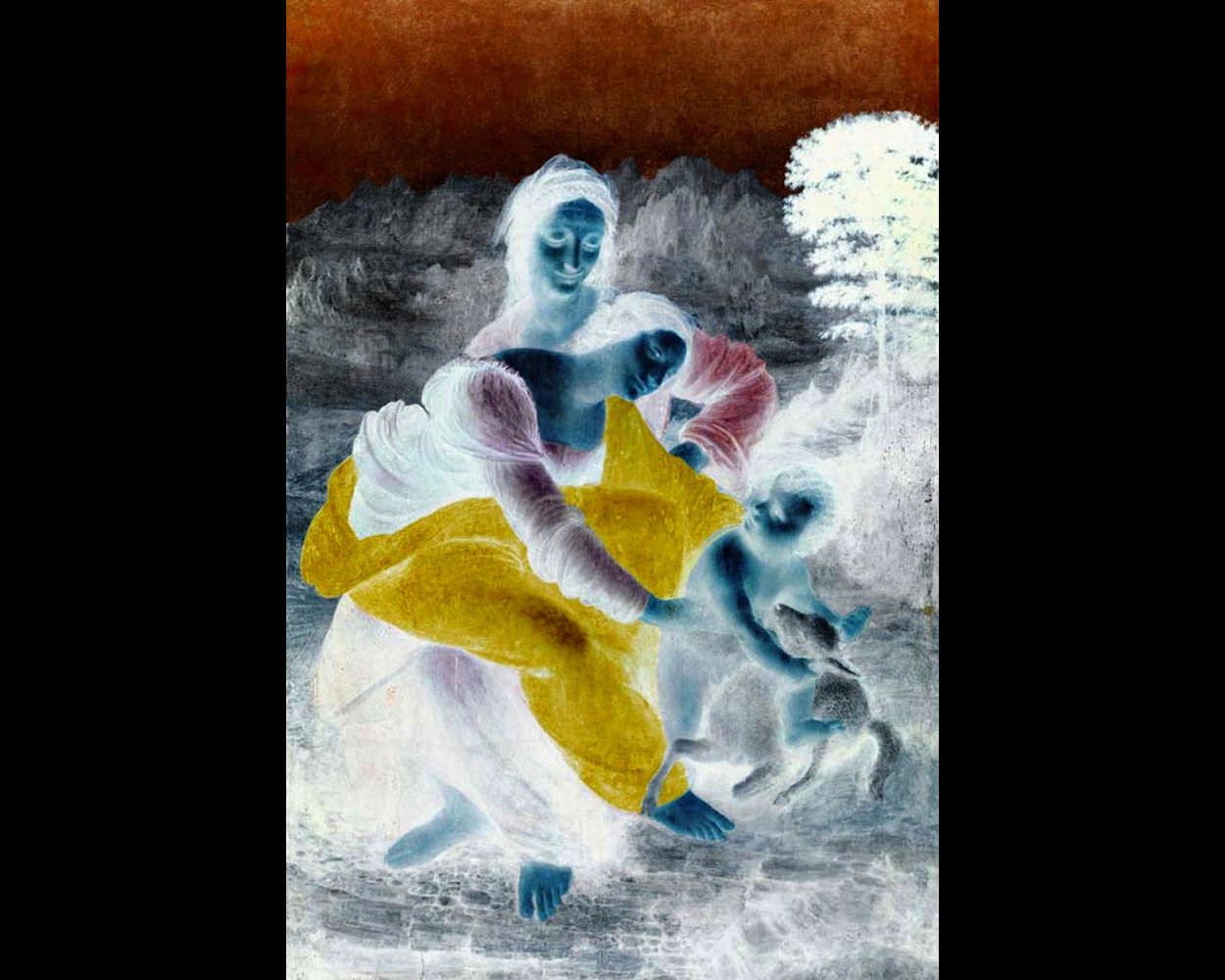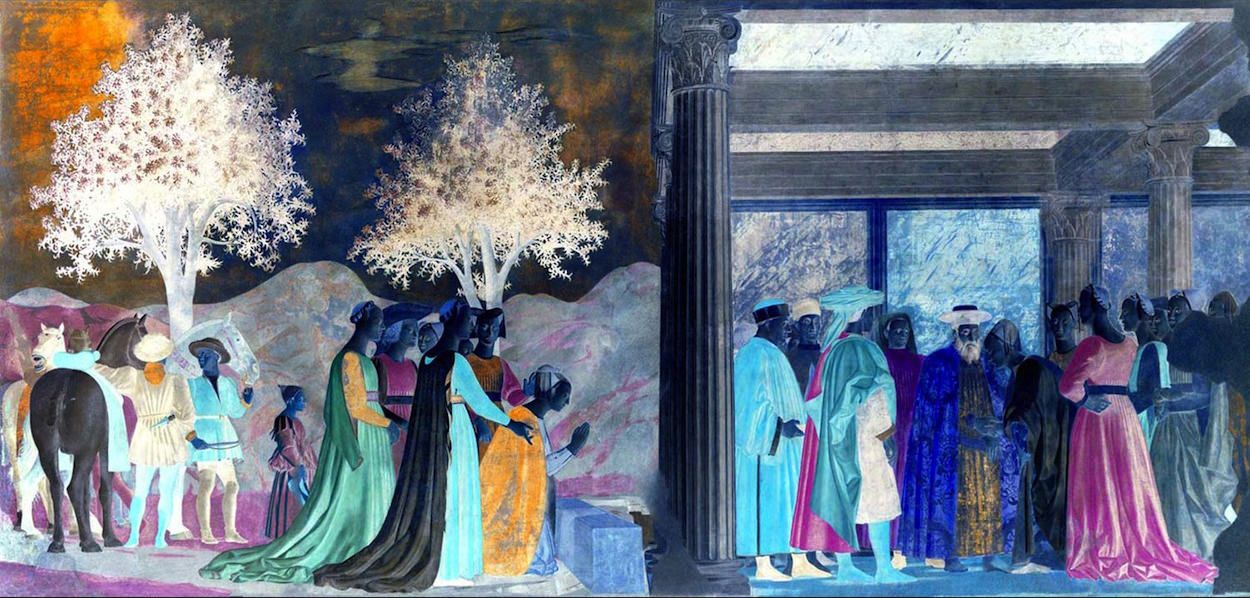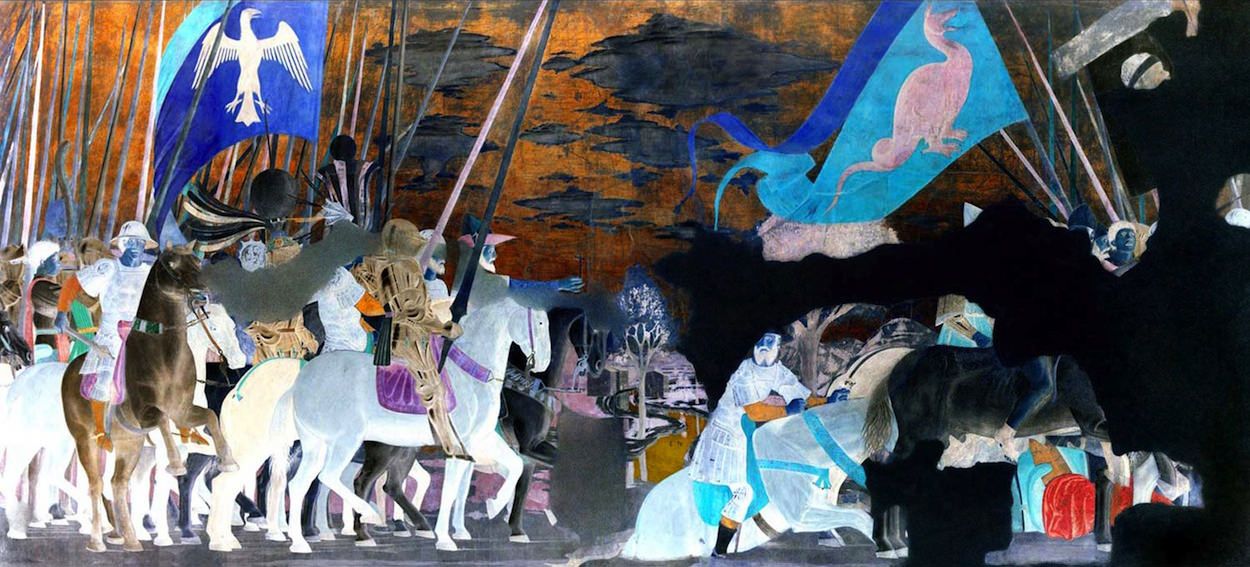Reversed renaissance
Start of work: 2004
The artist focuses on a number of masterpieces of Renaissance painting, reassessing them from a contemporary point of view. In this way, the old works acquire unusual meanings, permitting new interpretations. Thanks to the colour transformation and the reversal of the light and shade takes place in a semiotic process in which the signifier remains the same, while the signified may change radically. In this way, some of the original messages are perfectly adapted to the modern world.
Rainer Crone & Wouter Wirth
"The conceptual works of Francesco Pignatelli (born in 1971) erode the conventions of perception that have become consolidated over the years, and he achieves this by contrasting the pictorial works of Italian masters with the inherently mimetic medium of photography. By using the two media together, he brings about a sense of alienation and creates the conditions for giving potential new meaning to the works of the Renaissance. Both his works and those of Renaissance masters draw their vital spark from this, for both are newly and mutually reinvigorated. In order to do this, Pignatelli uses museum reproductions of works of the highest quality and he takes possession of the composition of the image (appropriation) using a combination of mechanical and individual-creative, almost pictorial processes, which makes it possible for a new aura to be created. In Francesco Pignatelli the photogrammetric captation of Renaissance works also playfully reflects the alternating relationship between imitation and alienation, and between original and appropriation, as a representation of today's media environment. In all of this, the theoretical process is genuinely semiotic. By recontextualising the signs that are consumed through differences of colour, almost incredibly, and for the first time, the artist discovers new meanings that could not be seen for what they were in the originals, or to which no significance of their own had been given. As a result, both in their generative process and in their final outcome, these works constitute a combination of a creative and semiotic-media work, since they also rediscover and invent the paintings. By doing so, they provide a present-day basis for their semiotic value and thus make it possible for the viewer to obtain an innovative, more acute vision of reliefs that are newly and semiotically inscribed." From an essay by Rainer Crone & Wouter Wirth. Munich, 2010.
"For Reversed Renaissance, Pignatelli has selected masterpieces of Renaissance art. All incorporate established motifs: the Annunciation, the Virgin and Child, the Last Supper. All address religious themes, have been renowned for centuries and have been scrutinized by innumerable eyes. What they also share is the cumulative grime of interpretation, amassed through the passage of time. The reputations of these and so many other historic paintings are now so firmly established that they seem unshakable. Encountering their world, we find ourselves imprisoned by conventional thinking. Struggle as we might to free our senses and sensibilities, we are slaves to an academicism that has tacitly imposed its seal of approval, its received interpretation.
...Pignatelli's method is to call into question a painting's status as a true image - a positive - by presenting its antithesis. The paintings in Reversed Renaissance are recreated through the eye of the camera, with the information the light conveys reversed on the negative. Pignatelli then works his own definitive art upon that negative image to create his finished work.
...In the paintings we see not only the effects of the layered colored materials and brushwork: the veil of time also covers the surface. Form results from adding colored materials that become progressively thicker. Over time, the color may darken or fade. In, however, the reversed world of Pignatelli's photographs, the images of these paintings are freed from discoloration. The thin, transparent film of the negative restores the purity of their creation. In the process, images are also freed from the values added by the fixed associations of their appearance on the plaster walls of churches, the cracked surfaces of altar panels, or canvases.
...The photograph was, to begin with, a memory device designed to capture a particular moment. Pignatelli's unique contribution to photographic art is to use it instead as a way of erasing the memories piled up since a painting was created. He denies or excludes the memories deposited layer by layer over hundreds of years. This act of purification, washing away the wall of time, dramatically shrinks the distance between the time in which a masterpiece was born and the time and space in which we view it. The effect is a virtual experience of a particular moment from the past that we cannot in fact touch. It is rooted in photography's fundamental ability to recall an image through the light and shadow created at a certain point in time. His approach, thus, rejects the absolute value ascribed to interpreting a painting as a masterpiece, with all the added value that has accreted upon its intrinsic value as a painting. Rejecting all that conventional values have attached to a painting, Pignatelli addresses the work itself with a purity and directness that restores spontaneity.
...Seeing the world reversed, with light and shadow changing places, expands our horizons. The complementary colors invert the language of the message. The Virgin Mary's blue robe, which communicates here innocence, turns yellow, blue's complement. West becomes East, the holy becomes the profane, bright lights are reversed into shadows. Antithesis gives birth to antithesis. A worldview is destroyed; unprecedented, totally new icons are created. In this visual world of endless, mysterious play, we who live in a new century find a new intellectual pleasure."
From an essay by Kyoko Jimbo (curator at Museum of Contemporary Art, Tokyo). Tokyo, 2006. Curator at Museum of Contemporary Art, Tokyo
The artist focuses on a number of masterpieces of Renaissance painting, reassessing them from a contemporary point of view. In this way, the old works acquire unusual meanings, permitting new interpretations. Thanks to the colour transformation and the reversal of the light and shade takes place in a semiotic process in which the signifier remains the same, while the signified may change radically. In this way, some of the original messages are perfectly adapted to the modern world.
Rainer Crone & Wouter Wirth
"The conceptual works of Francesco Pignatelli (born in 1971) erode the conventions of perception that have become consolidated over the years, and he achieves this by contrasting the pictorial works of Italian masters with the inherently mimetic medium of photography. By using the two media together, he brings about a sense of alienation and creates the conditions for giving potential new meaning to the works of the Renaissance. Both his works and those of Renaissance masters draw their vital spark from this, for both are newly and mutually reinvigorated. In order to do this, Pignatelli uses museum reproductions of works of the highest quality and he takes possession of the composition of the image (appropriation) using a combination of mechanical and individual-creative, almost pictorial processes, which makes it possible for a new aura to be created. In Francesco Pignatelli the photogrammetric captation of Renaissance works also playfully reflects the alternating relationship between imitation and alienation, and between original and appropriation, as a representation of today's media environment. In all of this, the theoretical process is genuinely semiotic. By recontextualising the signs that are consumed through differences of colour, almost incredibly, and for the first time, the artist discovers new meanings that could not be seen for what they were in the originals, or to which no significance of their own had been given. As a result, both in their generative process and in their final outcome, these works constitute a combination of a creative and semiotic-media work, since they also rediscover and invent the paintings. By doing so, they provide a present-day basis for their semiotic value and thus make it possible for the viewer to obtain an innovative, more acute vision of reliefs that are newly and semiotically inscribed." From an essay by Rainer Crone & Wouter Wirth. Munich, 2010.
"For Reversed Renaissance, Pignatelli has selected masterpieces of Renaissance art. All incorporate established motifs: the Annunciation, the Virgin and Child, the Last Supper. All address religious themes, have been renowned for centuries and have been scrutinized by innumerable eyes. What they also share is the cumulative grime of interpretation, amassed through the passage of time. The reputations of these and so many other historic paintings are now so firmly established that they seem unshakable. Encountering their world, we find ourselves imprisoned by conventional thinking. Struggle as we might to free our senses and sensibilities, we are slaves to an academicism that has tacitly imposed its seal of approval, its received interpretation.
...Pignatelli's method is to call into question a painting's status as a true image - a positive - by presenting its antithesis. The paintings in Reversed Renaissance are recreated through the eye of the camera, with the information the light conveys reversed on the negative. Pignatelli then works his own definitive art upon that negative image to create his finished work.
...In the paintings we see not only the effects of the layered colored materials and brushwork: the veil of time also covers the surface. Form results from adding colored materials that become progressively thicker. Over time, the color may darken or fade. In, however, the reversed world of Pignatelli's photographs, the images of these paintings are freed from discoloration. The thin, transparent film of the negative restores the purity of their creation. In the process, images are also freed from the values added by the fixed associations of their appearance on the plaster walls of churches, the cracked surfaces of altar panels, or canvases.
...The photograph was, to begin with, a memory device designed to capture a particular moment. Pignatelli's unique contribution to photographic art is to use it instead as a way of erasing the memories piled up since a painting was created. He denies or excludes the memories deposited layer by layer over hundreds of years. This act of purification, washing away the wall of time, dramatically shrinks the distance between the time in which a masterpiece was born and the time and space in which we view it. The effect is a virtual experience of a particular moment from the past that we cannot in fact touch. It is rooted in photography's fundamental ability to recall an image through the light and shadow created at a certain point in time. His approach, thus, rejects the absolute value ascribed to interpreting a painting as a masterpiece, with all the added value that has accreted upon its intrinsic value as a painting. Rejecting all that conventional values have attached to a painting, Pignatelli addresses the work itself with a purity and directness that restores spontaneity.
...Seeing the world reversed, with light and shadow changing places, expands our horizons. The complementary colors invert the language of the message. The Virgin Mary's blue robe, which communicates here innocence, turns yellow, blue's complement. West becomes East, the holy becomes the profane, bright lights are reversed into shadows. Antithesis gives birth to antithesis. A worldview is destroyed; unprecedented, totally new icons are created. In this visual world of endless, mysterious play, we who live in a new century find a new intellectual pleasure."
From an essay by Kyoko Jimbo (curator at Museum of Contemporary Art, Tokyo). Tokyo, 2006. Curator at Museum of Contemporary Art, Tokyo


